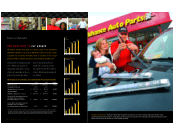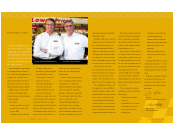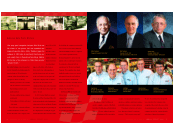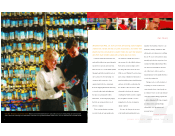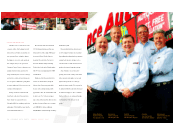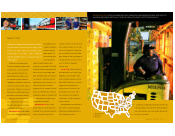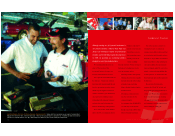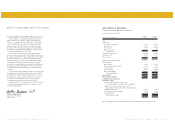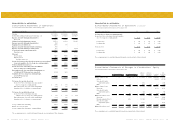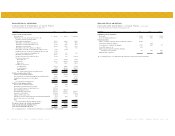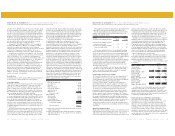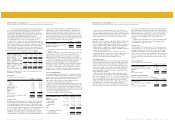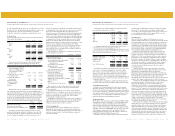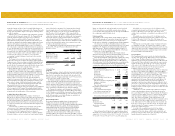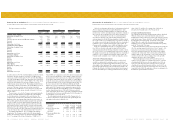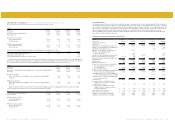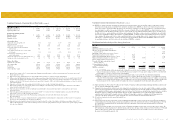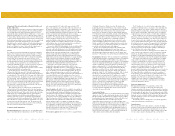Advance Auto Parts 2001 Annual Report Download - page 14
Download and view the complete annual report
Please find page 14 of the 2001 Advance Auto Parts annual report below. You can navigate through the pages in the report by either clicking on the pages listed below, or by using the keyword search tool below to find specific information within the annual report.
22 ADVANCE AUTO PARTS ANNUAL REPORT 2001 ADVANCE AUTO PARTS ANNUAL REPORT 2001 23
Advance Auto Parts, Inc. and Subsidiaries
Notes to Consolidated Financial Statements
December 29, 2001, December 30, 2000 and January 1, 2000
(in thousands, except per share data and per store data)
1. Organization and Description of Business:
On November 28, 2001, Advance Holding Corporation (“Holding”) was
merged with and into Advance Auto Parts, Inc. (“Advance”) with Advance
continuing as the surviving entity. Shareholders of Holding received one
share of Advance common stock in exchange for each outstanding share
of Holding common stock. In addition, separate classes of common stock
were eliminated, the par value of each share of common stock and
preferred stock was set at $0.0001 and $0.0001 per share, respectively,
and 100,000 and 10,000 shares of common stock and preferred stock were
authorized, respectively. This transaction was a reorganization among
entities under common control and has been treated in a manner similar to
a pooling of interests. Accordingly, the accompanying financial statements
have been changed to reflect this transaction as if it occurred on January
2, 1999. Advance was created in August 2001 and had no separate
operations. Accordingly, the change resulted only in reclassifications
between common stock and additional paid-in capital.
Advance and its Subsidiaries (the “Company”) maintain a Retail and
Wholesale segment within the United States, Puerto Rico and the Virgin
Islands. The Retail segment operates 2,484 retail stores under the
“Advance Auto Parts”, “Western Auto” and “Discount Auto Parts” trade
names. The Advance Auto Parts stores offer automotive replacement parts,
accessories and maintenance items throughout the Northeastern,
Southeastern and Midwestern regions of the United States, with no
significant concentration in any specific area. The Western Auto stores,
located in Puerto Rico, the Virgin Islands and one Company owned store
in California offer certain home and garden merchandise in addition to
automotive parts, accessories and service. The Discount Auto Parts stores
offer automotive replacement parts, accessories and maintenance items
throughout the Southeast portion of the United States. The Wholesale
segment consists of the wholesale operations, including distribution
services to approximately 470 independent dealers located throughout the
United States, primarily operating under the “Western Auto” trade name.
2. Summary of Significant Accounting Policies:
Accounting Period
The Company’s fiscal year ends on the Saturday nearest the end of December.
Principles of Consolidation
The consolidated financial statements include the accounts of Advance
and its wholly owned subsidiaries. All significant intercompany balances
and transactions have been eliminated in consolidation.
Use of Estimates
The preparation of financial statements in conformity with accounting
principles generally accepted in the United States requires management to
make estimates and assumptions that affect the reported amounts of assets
and liabilities and the disclosure of contingent assets and liabilities at the
date of the financial statements and the reported amounts of revenues and
expenses during the reporting period. Actual results could differ from
those estimates.
Cash, Cash Equivalents and Bank Overdrafts
Cash and cash equivalents consist of cash in banks and money market
funds. Bank overdrafts include net outstanding checks not yet presented to
a bank for settlement.
Vendor Incentives and Change in Accounting Method
The Company receives incentives from vendors related to cooperative
advertising allowances, volume rebates and other miscellaneous
agreements. Many of the incentives are under long-term agreements
(terms in excess of one year), while others are negotiated on an annual
basis. Cooperative advertising revenue restricted by our vendors for
advertising use only requires us to submit proof of advertising. These
restricted cooperative advertising allowances are recognized as a reduction
to selling, general and administrative expenses as advertising expenditures
are incurred. Unrestricted cooperative advertising revenue (i.e. does not
require proof of advertising), rebates and other miscellaneous incentives
are earned based on purchases and/or the turn of inventory. The Company
records unrestricted cooperative advertising and volume rebates earned as
a reduction of inventory and recognizes the incentives as a reduction to
cost of sales as the inventory is sold. The Company recognizes the
incentives earned related to other incentives as a reduction to cost of sales
over the life of the agreement based on the timing of purchases. These
incentives are not recorded as reductions to inventory. The amounts earned
under long-term arrangements not recorded as reduction of inventory are
based on our estimate of total purchases that will be made over the life of
the contracts and the amount of incentives that will be earned. The
incentives are generally recognized based on the cumulative purchases as
a percentage of total estimated purchases over the life of the contract. The
Company’s margins could be impacted positively or negatively if actual
purchases or results differ from our estimates but over the life of the
contract would be the same. Short-term incentives are recognized as a
reduction to cost of sales over the course of the annual agreement term
and are not recorded as reductions to inventory.
Amounts received or receivable from vendors that are not yet earned
are reflected as deferred revenue in the accompanying consolidated
balance sheets. Management’s estimate of the portion of deferred revenue
that will be realized within one year of the balance sheet date has been
included in other current liabilities in the accompanying consolidated
balance sheets. Total deferred revenue is $17,046 and $26,994 at
December 29, 2001 and December 30, 2000. Earned amounts that are
receivable from vendors are included in receivables, net on the
accompanying consolidated balance sheets.
Effective December 31, 2000, the Company changed its method of
accounting for unrestricted cooperative advertising funds received from
certain vendors to recognize these payments as a reduction to the cost of
inventory acquired from these vendors. Previously, these funds were
accounted for in the same manner as restricted cooperative advertising
allowances. The new method was adopted to better align the reporting of
these payments with the Company’s and the vendors’ use of these
payments as reductions to the price of inventory acquired from the
vendors. The effect of the change in fiscal 2001 was to increase income
from continuing operations by $358. The cumulative effect of retroactive
application of the change on the year ended December 29, 2001, was to
reduce income before extraordinary item by approximately $2,065, net of
$1,360 income tax, or $0.07 per share. The pro forma amounts shown on
the statement of operations have been adjusted for the effect of retroactive
application of the new method on net income and related income taxes for
all periods presented
Preopening Expenses
Preopening expenses, which consist primarily of payroll and occupancy
costs, are expensed as incurred.
Advertising Costs
The Company expenses advertising costs as incurred. Advertising expense
incurred was approximately $56,698, $53,658, and $65,524 in fiscal 2001,
2000 and 1999, respectively.
Merger and Integration Costs
As a result of the Western Merger (Note 4) and the Discount acquisition
(Note 3), the Company incurred, and will continue to incur through fiscal
2002 in connection with the Discount acquisition, costs related to, among
other things, overlapping administrative functions and store conversions
that have been expensed as incurred. These costs are presented as
expenses associated with the merger and integration in the accompanying
statements of operations.
Warranty Costs
The Company’s vendors are primarily responsible for warranty claims.
Warranty costs relating to merchandise and services sold under warranty,
which are not covered by vendors’ warranties, are estimated based on the
Company’s historical experience and are recorded in the period the
product is sold.
Revenue Recognition and Trade Receivables
The Company recognizes merchandise revenue at the point of sale to a
retail customer and point of shipment to a wholesale customer, while
service revenue is recognized upon performance of service. The majority
of sales are made for cash; however, the Company extends credit to
certain commercial customers through a third-party provider of private
label credit cards. Receivables under the private label credit card program
are transferred to the third-party provider on a limited recourse basis. The
Company provides an allowance for doubtful accounts on receivables sold
with recourse based upon factors related to credit risk of specific
customers, historical trends and other information. This arrangement is
accounted for as a secured borrowing. Receivables and the related secured
borrowings under the private label credit card were $16,400 and $15,666
at December 29, 2001 and December 30, 2000, respectively, and are
included in accounts receivable and other current liabilities, respectively,
in the accompanying consolidated balance sheets. Additionally, at
December 29, 2001, Discount had $3,457 in trade receivables under their
commercial credit program.
Change in Accounting Estimate
In July of fiscal 2000, the Company adopted a change in an accounting
estimate to reduce the depreciable lives of certain property and equipment
on a prospective basis. The effect on operations was to increase
depreciation expense by $2,458 for fiscal 2000. At December 29, 2001,
the effected assets were fully depreciated.
Earnings Per Share of Common Stock
Basic earnings per share of common stock has been computed based on
the weighted-average number of common shares outstanding during the
period. Diluted earnings per share of common stock reflects the increase
in the weighted-average number of common shares outstanding assuming
the exercise of outstanding stock options, calculated on the treasury stock
method. The number of outstanding stock options considered antidilutive
for either part or all of the fiscal year and not included in the calculation
of diluted net income (loss) per share for the fiscal years ended December
29, 2001, December 30, 2000 and January 1, 2000 were 509, 1,566 and
230, respectively.
Recent Accounting Pronouncements
In June 1998, the Financial Accounting Standards Board (““FASB”)
issued Statement of Financial Accounting Standards (“SFAS”) No. 133,
“Accounting for Derivative Instruments and Hedging Activities”. This
Statement establishes accounting and reporting standards for derivative
instruments, including certain derivative instruments embedded in other
contracts (collectively referred to as derivatives) and for hedging activities.
It requires companies to recognize all derivatives as either assets or
liabilities in their statements of financial position and measure those
instruments at fair value. In September 1999, the FASB issued SFAS No.
137, “Accounting for Derivative Instruments and Hedging Activities—
Deferral of the Effective Date of FASB Statement No. 133,” which
delayed the effective date of SFAS No. 133 to fiscal years beginning after
June 15, 2000. The FASB issued also SFAS No. 138, “Accounting for
Derivative Instruments and Certain Hedging Activities—an Amendment
of SFAS No. 133,” which amended the accounting and reporting standards
for certain risks related to normal purchases and sales, interest and foreign
currency transactions addressed by SFAS No. 133. The Company adopted
SFAS No. 133 on December 31, 2000 with no material impact on
financial position or results of its operations.
In September 2000, the FASB issued SFAS No. 140, “Accounting for
Transfers and Servicing of Financial Assets and Extinguishment of
Liabilities—a Replacement of FASB Statement No. 125”. This statement
replaces SFAS No. 125, but carries over most of the provisions of SFAS
No. 125 without reconsideration. The Company implemented SFAS No.
140 during the first quarter of fiscal 2001. The implementation had no
impact on the Company’s financial position or results of operations.
In June 2001, the FASB issued SFAS No. 141, “Business
Combinations” and No. 142, “Goodwill and Other Intangible Assets”.
SFAS No. 141 addresses accounting and reporting for all business
combinations and requires the use of the purchase method for business
combinations. SFAS No. 141 also requires recognition of intangible assets
apart from goodwill if they meet certain criteria. SFAS No. 142
establishes accounting and reporting standards for acquired goodwill and
other intangible assets. Under SFAS No. 142, goodwill and intangibles
with indefinite useful lives are no longer amortized but are instead subject
to at least an annual assessment for impairment by applying a fair-value
based test. SFAS No. 141 applies to all business combinations initiated
Advance Auto Parts, Inc. and Subsidiaries Notes to Consolidated Financial Statements (continued)
December 29, 2001, December 30, 2000 and January 1, 2000 (in thousands, except per share data and per store data)


